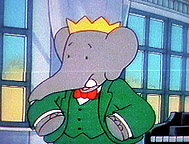Babar in Latin America



Babar in Latin America


A synopsis of a synopsis of the story of Babar the Elephant King:
Babar grew up in an African jungle in the company of other elephants. One day, this world is shattered by a wicked hunter who kills Babar's mother. He escapes to Paris and is adopted by an old human lady, where he begins his human education. He becomes human by learning to use a napkin, sleeping in a bed, performing exercise, getting his photo taken, taking a bath in a tub with a sponge, driving his own car and dressing in the latest fashion. And he learns to read and write, add and subtract, and interpret history and geography.
Soon, Babar's two cousins --- Celeste and Arthur --- show up at the doorsteps of the mansion. They are also brought into the old lady's household and learn to become civilized too. Eventually, they all leave Paris to visit the land of the elephants, all dressed up and driving a car.
Meanwhile, the king of the elephants has just died, and the three oldest elephants get together to choose a new king. Babar's arrival is therefore timely and momentous. His dress and car bear all the signs of westernization, which stands out from the undifferentiated mass of naked gray flesh of the elephants. So the elders crown Babar as the new king of the elephants. The coronation is celebrated simultaneously with Babar's wedding to his cousin Celeste, the only female who is his equal. All the animals get up on two legs for the first time to dance. Thus, ends the first book of Babar.
With a storyline like this, it is impossible for us today not to give it a reading in terms of colonialism and imperialism. The interested reader is urged to read Ariel Dorfman's book (see reference at the bottom of this page) for detailed analyses of Babar as well as other cultural icons such as Donald Duck, the Lone Ranger and Reader's Digest. Today, we can imagine that a book proposal like this is likely to be rejected immediately. But when Babar was first created by Maurice Sendak in 1931, the theme in fact matched the Zeitgeist of the day, as much of Africa were still colonies of the European powers.
In recent years, Babar appears in an animated television series that is being shown repeatedly all over the world. In the 1997 edition of the Pan Latin American Kids Study conducted by Audits & Surveys Worldwide, we found that 38% of Latin American kids between the ages of 7 and 11 have seen Babar on television. The table below shows the demographic breakdown of these viewers. The incidences are much higher in the two most Europeanized countries --- Argentina and Chile. Furthermore, the incidences are an increasing function of socio-economic level.
|
Demographic Variable / Class |
% Agree Mostly |
| Geographical Region Argentina Brazil Chile Colombia Mexico Puerto Rico Venezuela Balance of Central America Balance of South America |
58% 35% 79% 15% 34% 28% 33% 52% 33% |
| Sex Male Female |
39% 36% |
| Age 7-9 years old 10-11 years old |
38% 37% |
| Socio-Economic
Level Level "A" Level "B" Level "C" Level "D" |
55% 44% 37% 32% |
(Source: Pan Latin American Kids Study 1997, Audits & Surveys Worldwide)
Babar was not created by Maurice Sendak as a tool for imperialist propaganda. The story idea was originally made up by his wife for their children. The popularity of Babar was not due to its messages, but because of the tender, sensual and simple style of its illustrator. As a product of its time, it unfortunately assumed some of the prevalent values and attitudes. So how well is Babar received by its viewers today?
According to the Pan Latin American Kids Study 1997, of those Latin American kids who have ever seen Babar on television,
8% said that Babar is "one of their favorites"
52% said that they "like him a lot"
35% said that they "like him a bit"
6% said that they "did not like him"
Thus, Babar is not a polarizing character in the eyes of these children.
REFERENCES
Ariel Dorfman (1983). The Empire's New Clothes: What the Lone Ranger, Babar, and other innocent heroes do to our minds. Penguin Books: New York.
(posted by Roland Soong on 1/7/00)
(Return to Zona Latina's Home Page)